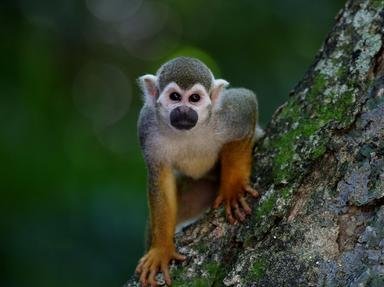Quiz Answer Key and Fun Facts
1. 'Pan paniscus' is one of two species in the 'Pan' genus, the other being the common chimpanzee. Also known as a pygmy chimpanzee, it is native to a relatively small area in the Congo Basin in central Africa. Which animal is this?
2. 'Pongo pygmaeus' is one of the two surviving species in the 'Pongo' genus. One of the most intelligent primates, they are the most solitary and the most arboreal of all great apes. Native to Indonesia and Malaysia, which creature is this?
3. 'Chlorocebus pygerythrus' is an Old World monkey native to southern and the eastern coast of Africa. Recognizable by their black faces, this species displays numerous human-like traits including anxiety and a propensity for alcohol dependency. Which species is this?
4. This Old World primate species is native to a small area on Africa's Atlantic coastline. Found mostly in tropical rainforests, they live in family groups called hordes. The world's largest monkey species, which animal is this?
5. 'Pygathrix nemaeus' (pictured) is one of three species in the Pygathrix genus. Native to southeast Asia, its physical characteristics include bright maroon legs and long tails that allow them to move agilely around their treetop habitat. Which type of primate is this?
6. The pictured primate is a member of a genus found virtually throughout the Old World. This specific species is native to Algeria and Morocco, but is perhaps most famous for the small population that was introduced into Gibraltar. Which species is this?
7. The pictured primate is one of numerous species within the Cebinae subfamily that is native to South and Central America. These primates were named after a group of Franciscan friars who wore brown robes with large hoods covering their heads. Which primates are these?
8. 'Callicebus cupreus' (pictured) is one of around 30 species within the Callicebus subgenus of South American primates. They can be found mostly in dense forests near water, jumping from tree to tree high in the canopy, hence their German name, 'Springaffen', meaning "jumping monkeys". Which type of animal is this?
9. 'Daubentonia madagascariensis' is a member of the lemur superfamily and a native of the island of Madagascar. The world's largest nocturnal primate, this is the only surviving species within the Daubentonia genus. Which species, with an unusual method of finding its food, is this?
10. "Star Wars" fans could be forgiven for thinking that this is a photograph of an early 'Yoda' model, but it is in fact a species of small primate native to Indonesia. This nocturnal creature lives in the mangrove forests, where it can be found clinging to vertical branches or leaping from tree to tree. Which type of primate is this?
Source: Author
EnglishJedi
This quiz was reviewed by FunTrivia editor
guitargoddess before going online.
Any errors found in FunTrivia content are routinely corrected through our feedback system.

